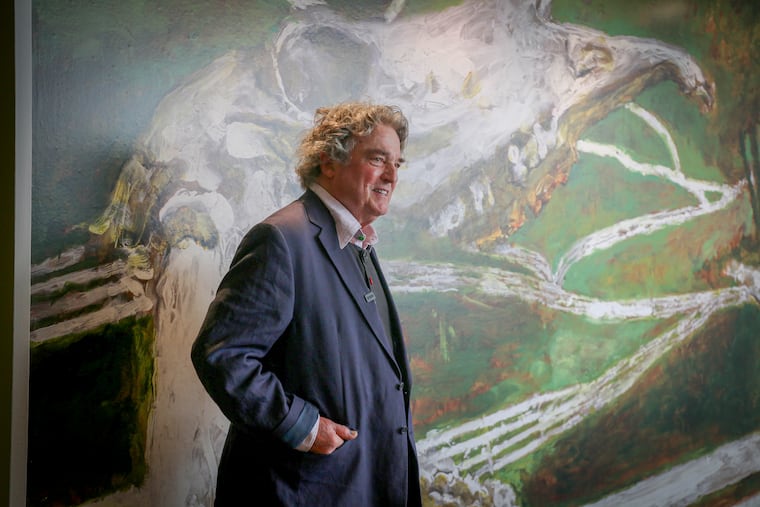Artist Jamie Wyeth finds inspiration in horror and beauty
“You can’t have one without the other, or at least it doesn’t appeal to me.”

In the middle of Jamie Wyeth and the Unflinching Eye, a new documentary by Glenn Holsten, there’s a scene where the artist, now in his 70s, hunches down and peers into something he never intended to exhibit — a replica of the spot where he and his late friend and mentor Andy Warhol ate lunch. Wyeth designed this tableau of Warhol’s studio (called the Factory) in 2013 — rendering it a kind of three-dimensional memory. Reminiscent of a macabre dollhouse, the tableau features a miniature moose head jutting from the wall and a figurine of Warhol sitting at his dining room table, watching his own sordid video on a tiny TV.
As the camera zooms in on Wyeth’s eye — glossy black pupil and thatched eyebrow — reflected in the tableau’s dining room mirror, the scene reveals him as a strange god mystified by his creation.
The Brandywine Museum of Art’s new show — “Jamie Wyeth: Unsettled” — allows viewers to peer into and be transfixed by Wyeth’s works.
Inspired by the thematic vein of eeriness that the museum’s head curator Amanda Burdan locates in Wyeth’s work, the exhibit (which will subsequently travel to Maine, Ohio, and Washington) features 60-plus pieces including oil and watercolor paintings, as well as mixed media assemblages including a tableau of a butcher’s shop, full-size portraits of humans paused at the threshold of actual screen doors, and even a taxidermied Chihuahua-sized dog.
While not officially a retrospective, the exhibition includes works from Wyeth’s teen years in the 1960s (Morgue Sketchbook) through paintings like Lightning Struck (1975) and ones made in 2022 in coastal Maine, where Wyeth resides for part of the year.
The son of Chadds Ford luminaries — the renowned figurative painter Andrew Wyeth and author, editor, and visionary Betsy Wyeth — Jamie Wyeth was born nine months after his grandfather, the famous illustrator N.C. Wyeth, died in a car accident on the train tracks that slice through the Brandywine Valley.
In what now seems like a premonition, Andrew Wyeth created a portrait of Jamie seated in a late autumn field (Faraway, 1952) when Jamie was 6. Clutching his knees, with his sober brown eyes looking askance, the boy’s face conveys a vibration of anxiety. A coonskin hat perches like a crown — as if he’s already governing an active, and perhaps disquieted, imagination, the results of which now haunt this exhibition.
Some of the most startling works are his images of animals. For instance, in Sheep Eyes (1968), the eyes of multiple sheep, piled up on a single page, ogle back at viewers with their unnerving square pupils.
“I always start with the eyes,” Wyeth said from his Maine home, noting that if he can’t get the eyes right, he’ll walk away from the subject. This watercolor sketch and another, Sheep Drawing with Letter (1968), were products of his obsession with a particular sheep that roamed one of the Maine islands near Monhegan. Text painted on this work reads, “His face is the blackest of blacks and his eyes an unearthly pale – he terrifies me.” Wyeth mailed this study to another of his mentors, cultural lion Lincoln Kirstein. “I was so swept away by the sheep,” Wyeth said, “that [Kirstein] thought I was completely over the hill, which I was.” But Kirstein saved the work, and when he died in 1996, he left the work to Wyeth.
Another image that has returned to haunt Wyeth are the whiteface angus cattle he painted in oil, enamel, and acrylic in A Midsummer Night’s Dusk (2022). Though he hadn’t raised cattle in decades, and never considered them particularly menacing, he had a dream in which they clustered together with their horror movie hockey mask faces. In his imagination, the cattle tramping back toward the barn in the evening became this “sort of threatening thing coming towards you.”
Another painting in the exhibit features an animal whose eyes are filmed over by death. Deer Head II (ca. 1965) was made in Chadds Ford. As a teen, Wyeth would take a backpack and walk for miles along the railroad tracks — which he describes as “kind of threatening, but wonderful too.”
He was used to seeing deer on those forays, lithe and fleeing, but on one occasion, he found a head — sheared off and still. Wyeth recalled how he was struck: “Here it was, thrown off the tracks down this embankment, but wasn’t as much the horror [of it]; it was really the beauty of the thing.”
Horror that is simultaneously beautiful? “Well, that’s the opiate,” Wyeth says. “They’re sort of totally married together. I mean, you know, you can’t have one without the other, or at least it doesn’t appeal to me.”
And so, 20 years after his grandfather’s death, not far from where he had posed for his father’s Faraway, Wyeth sank down in the late autumn grass. Shaken by the sight of the deer’s head, he thought to himself, “Well, why don’t I record it?”
He unpacked his watercolors. With his pad braced on his lap, he peered intensely at mortality. He started with the glazed-over eye, and soon his brushstrokes were running across the page.
“Jamie Wyeth: Unsettled” runs through June 9 at Brandywine Museum of Art, 1 Hoffman’s Mill Road, Chadds Ford, Pa. 19317
“Jamie Wyeth and the Unflinching Eye” by Glenn Holsten (husband of Inquirer classical music critic Peter Dobrin) just concluded its New York theatrical run and is being distributed by Juno Films.